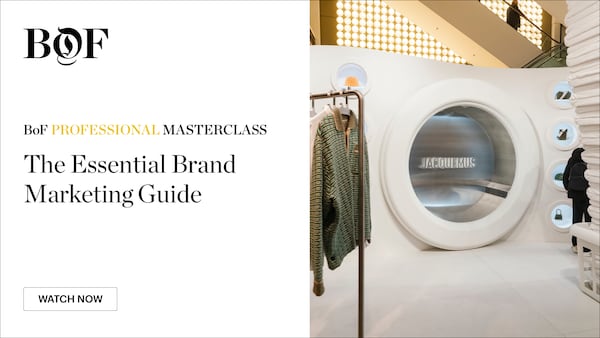
The Business of Fashion
Agenda-setting intelligence, analysis and advice for the global fashion community.

Agenda-setting intelligence, analysis and advice for the global fashion community.

Today’s brands need to be more than just a label on a sweater or a logo on a shopping bag.
It’s in part a reflection of the deepening convergence of fashion and beauty with everything from sports to music to pop culture generally, enabling brands to touch so many different aspects of consumers’ lives. In turn, consumers have high expectations of the brands they choose to let into their lives — whether it means aligning around social and political causes or amplifying certain lifestyles or aspirations.
“The brand is where actual value is created, and where customers feel that there’s a value because there’s more to it than just what’s in the box,” said Tiffany Rolfe, global chief creative officer of advertising agency R/GA.
Beauty and fashion products with recognisable, emotionally resonant brand identities behind them, often synonymous with a lifestyle or persona, will stand out. Ralph Lauren’s visual embrace of Americana, from cowboy-style Western to New England prep, for example, permeates every aspect of the brand, from its ad campaigns to its brick-and-mortar stores to its products. That identity has turned it into the quintessential American fashion brand.
ADVERTISEMENT
But how can a brand stand out in today’s fiercely competitive, crowded market, as customers have become choosier about their discretionary purchases? This case study shows how brand marketing holds the key to creating the essence of a brand: by conveying a brand’s values and identity to consumers. It’s not about a one-off runway show or pop-up, rather an ongoing trajectory reshaped over time. Effective brand marketing not only builds an identity, but also creates communities of loyal customers and even opens new markets and other opportunities for business growth.
In some ways, it’s easier to invest in building a brand earlier on in a company’s lifespan — there’s minimal overhead, fewer employees and less oversight on spending. Founders with a strong intuition can execute on their vision and take risks that end up paying off. Take J.Crew: The brand was able to establish itself with its visual-heavy catalogues when it was still a family-run business in the 1980s and 1990s. Once it took on a majority investment, that vision began to falter. (Though it later resurged under the direction of chief executive Mickey Drexler.)
The challenge is to maintain that vision even as other factors begin to play more of a role in a business’ direction. Companies that are under pressure from investors or shareholders to shore up the balance sheet may find themselves de-prioritising brand marketing investments, whose impact isn’t always immediately evident in near-term sales growth. But the strongest brands can see the bigger picture and know that investing in brand marketing is worth the time and cash.
Recent years have seen many brands lose that vision as they prioritised performance marketing. The boom in performance marketing, which began in the early 2010s, was driven by the rise of more novel and cheaper marketing methods, where brands pay for their marketing initiatives based on the results, such as clicks or conversions on social media and search. It was a slam-dunk way for brands to simultaneously acquire customers and build their businesses rapidly. Even today as social media ads become more costly and less effective, performance marketing is critical for fashion and beauty companies.
But as this case study shows, brand marketing too needs to be part of the mix to create closer, longer-lasting connections with customers, regardless of a company’s age or size.
With seemingly endless products to buy, it’s the brand that makes the difference. Consumers will spend upwards of $10,000 on a Chanel bag not because the quality is so superior to its $2,000 counterparts, but because of the strength of the brand.
“When you hear that brand name, you want a clear, focused idea and story to come into your head,” said Allen Adamson, chief executive of marketing agency Metaforce and adjunct professor at New York University’s Stern School of Business.
Companies profiled in this case study are striving for deep, long-lasting connections with customers, as they strategise around in-person and digital events, social media and often old-fashioned advertising on TV, radio and billboards. French luxury label Jacquemus has written the playbook for modern brand building by demonstrating how to bring a brand’s online persona to life offline. The story of another luxury label — heritage brand Coach — shows the importance of evolving and modernising brand identities to remain relevant. And two young brands — Dae Hair and Hill House Home — have proven the power of using community to build a brand in a short amount of time.

BoF Insights and Quilt.AI co-created The BoF Brand Magic Index to examine if customers see a brand the same way a brand sees itself. The Index quantifies and ranks 50 global luxury and fashion labels using AI-driven analysis of tens of thousands of social media posts by brands and their customers.
Watch on demand a BoF Professional Masterclass that explores the topic in our Case Study, “The Essential Brand Marketing Guide.”

Diana Pearl is News and Features Editor at The Business of Fashion. She is based in New York and drives BoF’s marketing and media coverage.
Calvin Klein’s chief marketing officer Jonathan Bottomley speaks to Imran Amed about the strategy behind the brand’s buzzy Jeremy Allen White-fronted campaign.
Often left out of the picture in a youth-obsessed industry, selling to Gen-X and Baby Boomer shoppers is more important than ever as their economic power grows.
This month, BoF Careers provides essential sector insights to help PR & communications professionals decode fashion’s creative landscape.
The brand’s scaled-back Revolve Festival points to a new direction in its signature influencer marketing approach.